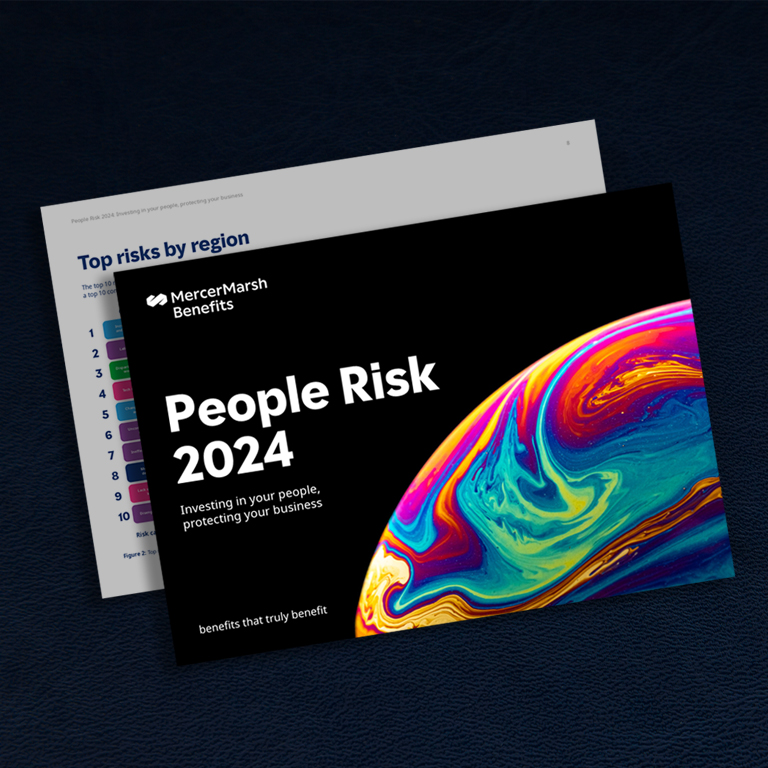By, Samantha Hayes and Blake Gleeson ,
13/07/2022 · 6 min read
A focus on health and well-being in building resilience has led C-suites to be more involved in benefit and risk management decisions.
This is good news, but with such increased scrutiny comes higher levels of attention on ensuring accuracy in administration and prudence in managing employee benefit plans.
This was reflected in our People Risk Report 2022. We found that administration and fiduciary risk is ranked as the second-highest risk across all 25 studied risks, according to risk managers and HR professionals.
As concerns about a recession rise to the top of C-suite agendas, it’s no surprise that more visibility into key spend areas would be top of the list for employers as they continue to do their best to hold onto profits and increase liquidity while navigating a tight labor market. Inflation will trigger further dialogue on getting plan design right as medical plan deductibles erode and employees express concerns regarding benefit adequacy.
However, only 41% of organizations have reported an effective governance approach to insurance and benefit design, while 42% have reported that they have an effective cost containment strategy in place today. Only half of companies are investing in managing this risk in the next 1-2 years.
Firms should urgently tackle this issue and put controls in place to ensure that costs and liabilities associated with benefit plans don’t unintentionally spiral out of control, and to make sure that benefits are designed, delivered, and financed in a way that provides value for money.
Governance and financial risk is viewed as a serious threat to business by 8 in 10 (78%) risk and HR managers.
We aren’t surprised that administration and fiduciary risk ranked second out of 25 based on a risk rating score (we called it out as a blind spot last year) given the consequences of situations going wrong and scrutiny increasingly being placed on rewards and investment managers to adapt to new standards.
Regulations ranging from new compensation disclosure requirements to changing workplace health and safety legislation is compounding the desire for simplicity in plan management. Many are also feeling pressure from stakeholders to advance sustainability; for example, by investing funds in a responsible manner or elevating working standards.
The challenges experienced by operations dealing with a lack of administrative automation during the pandemic is still top of mind. For example, a national employer in Australia must navigate different legislative requirements for workers’ compensation and workplace health and safety for all eight states and territories, thus compounding the level of complexity and skills required to manage a compliant plan.
A lack of consistency in how employee rewards and other programs are applied can lead to large room for error, reputational risk, and legal implications, which can subsequently impact employee morale. Strides have been made in the last few years in many geographies where more transparent and engaging methods of interacting with employees regarding their benefits via digital front doors have been introduced. However, these are still in the early stages in many markets, and antiquated systems and processes have resulted in slower-than-ideal response times at moments that mattered during the pandemic. Manual protocols and decentralized systems within current processes and systems continue to be cause for concern with respect to data loss and inaccuracy.
After an explosion of unexpected but required changes due to the pandemic and the critical focus on societal issues including diversity, equity, and inclusion, now is the time to examine overdue processes and items that have been taken for granted. Firms should consider going back to basics; for example, having advisors who can monitor regulatory environments. Bahrain, Qatar, and Oman are all exploring moves to make medical insurance compulsory for all employees. Likewise in the United Arab Emirates and Saudi Arabia, we are seeing the regulatory bodies continue to introduce and enhance minimum standards of benefits within medical plans.
Now that organizations have some breathing room, tackling these issues should be top of the agenda. Basic inventories of plans, premiums, insurers, and necessary disclaimers and coverages, particularly for multinational or complex employers, can allow employers to move quickly to deploy those solutions in a time of crisis.
Organizations must also engage in plan and risk management by creating sophisticated governance approaches that are not just tied to annual insurance cycles. It’s about building a cadence to address risk before it spirals out of control.
Medical costs continue to rise at a pace that is two times greater than that of general inflation[1]. Employers should anticipate that renewal premiums will increase to compensate for volatility as a result of the pandemic, deferred care, long COVID, and changes in employees’ lifestyles.
Globally, employers have tried to manage costs, often in conjunction with the annual renewal of insured benefits. However, while modest year-on-year changes are important for keeping plans within budget, they do not typically make a long-term dent in cost growth.
This means making sure that you:
The health and resilience of your workforce is integral to the company’s success and resilience. The main focus for organizations should be governance to make sure that benefits design and delivery changes are being made for the right reasons and that these mitigate business risk.
With more organizations planning to elevate the role of benefits within the employee value proposition, they must consider how they will take the design, delivery, and financing of benefits to the next level, supported by a longer-term strategy, more rigorous stakeholder communication, and decision-making analytics along the way.
[1] Marsh. Health Trends Report. Global Insurer Report. Available at https://www.marsh.com/ug/services/employee-health-benefits/insights/health-trends-report.html

MENA Senior Regional Hub Consultant, MMB

Chief Client Officer, MMB

Report
22/04/2024